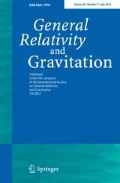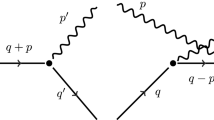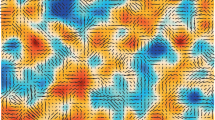Abstract
The Cosmic Microwave Background is characterized by temperature and linear polarization fields. Dipole modulation in the temperature field has been extensively studied in the context of hemispherical power asymmetry. In this article, we show that a dipole modulation, and in general, any kind of modulation isn’t allowed in the E and B modes. This is the main result of this paper. This result explains why no evidence of modulation in E mode has been found in the literature. On the contrary, the linear polarization fields Q and U have no such restrictions. We show that modulation under certain situations can be thought of as local U(1) gauge transformations on the surface of a sphere. As far as the modulation function is concerned, we show that physical considerations enforce it to be (i) a spin 0 field and (ii) a scalar under parity. As masking is a specific type of modulation, our study suggests that a direct masking of E mode isn’t also possible. Masking in E map can only be applied through Q and U fields. This means that in principle, leaking of E and B mode powers into each other is unavoidable.

Similar content being viewed by others
Data availibility
No new data was generated or analysed in support of this research.
Notes
In general, a field \(\Psi \) on a sphere \({\mathbb {S}}^2\) has spin s, if under a right handed rotation of the local coordinate system by an angle \(\alpha \), it transforms as \(\Psi \mapsto \Psi '=\Psi e^{-is\alpha }\).
References
Zaldarriaga, M., Seljak, U.: An all sky analysis of polarization in the microwave background. Phys. Rev. D 55, 1830 (1997). arXiv:astro-ph/9609170
Sadegh, M., Mohammadi, R., Motie, I.: Generation of circular polarization in CMB radiation via nonlinear photon-photon interaction. Phys. Rev. D 97, 023023 (2018). arXiv:1711.0
Vahedi, A., Khodagholizadeh, J., Mohammadi, R., Sadegh, M.: Generation of circular polarization of CMB via polarized Compton scattering. JCAP 01, 052 (2019). https://doi.org/10.1088/1475-7516/2019/01/052. arXiv:1809.08137
Bartolo, N., Hoseinpour, A., Matarrese, S., Orlando, G., Zarei, M.: CMB circular and B-mode polarization from new interactions. Phys. Rev. D (2019). https://doi.org/10.1103/PhysRevD.100.043516. arXiv:1903.04578
Eriksen, H., Hansen, F., Banday, A., Gorski, K., Lilje, P.: Asymmetries in the cosmic microwave background anisotropy field. Astrophys. J. 605, 14 (2004). https://doi.org/10.1086/382267. arXiv:astro-ph/0307507
Hoftuft, J., Eriksen, H., Banday, A., Gorski, K., Hansen, F., Lilje, P.: Increasing evidence for hemispherical power asymmetry in the five-year WMAP data. Astrophys. J. 699, 985 (2009). https://doi.org/10.1088/0004-637X/699/2/985. arXiv:0903.1229
Eriksen, H.K., Banday, A., Gorski, K., Hansen, F., Lilje, P.: Hemispherical power asymmetry in the three-year Wilkinson microwave anisotropy probe sky maps. Astrophys. J. Lett. 660, L81 (2007). https://doi.org/10.1086/518091. arXiv:astro-ph/0701089
Planck Collaboration: Planck 2013 results. XXIII. Isotropy and statistics of the CMB. Astron. Astrophys. 571, A23 (2014) https://doi.org/10.1051/0004-6361/201321534arXiv:1303.5083
Planck Collaboration: Planck 2015 results. XVI. Isotropy and statistics of the CMB. Astron. Astrophys. 594, A16 (2016) https://doi.org/10.1051/0004-6361/201526681arXiv:1506.07135
Planck Collaboration: Planck 2018 results. VII. Isotropy and statistics of the CMB. Astron. Astrophys. 641, A7 (2020) https://doi.org/10.1051/0004-6361/201935201arXiv:1906.02552
Gordon, C., Hu, W., Huterer, D., Crawford, T.M.: Spontaneous isotropy breaking: a mechanism for CMB multipole alignments. Phys. Rev. D (2005). https://doi.org/10.1103/PhysRevD.72.103002. arXiv:astro-ph/0509301
Gordon, C.: Broken isotropy from a linear modulation of the primordial perturbations. Astrophys. J. 656, 636 (2007). https://doi.org/10.1086/510511. arXiv:astro-ph/0607423
Prunet, S., Uzan, J.-P., Bernardeau, F., Brunier, T.: Constraints on mode couplings and modulation of the CMB with WMAP data. Phys. Rev. D 71, 083508 (2005). https://doi.org/10.1103/PhysRevD.71.083508. arXiv:astro-ph/0406364
Bennett, C., et al.: Seven-year Wilkinson microwave anisotropy probe (WMAP) observations: are there cosmic microwave background anomalies? Astrophys. J. Suppl. 192, 17 (2011). https://doi.org/10.1088/0067-0049/192/2/17. arXiv:1001.4758
Hajian, A., Souradeep, T.: Measuring statistical isotropy of the CMB anisotropy. Astrophys. J. Lett. 597, L5 (2003). https://doi.org/10.1086/379757. arXiv:astro-ph/0308001
Pullen, A.R., Kamionkowski, M.: Cosmic microwave background statistics for a direction-dependent primordial power spectrum. Phys. Rev. D (2007). https://doi.org/10.1103/PhysRevD.76.103529. arXiv:0709.1144
Kothari, R., Ghosh, S., Rath, R.K., Kashyap, G., Jain, P.: Imprint of inhomogeneous and anisotropic primordial power spectrum on CMB polarization. Mon. Not. R. Astron. Soc. 460, 1577 (2016). https://doi.org/10.1093/mnras/stw1039. arXiv:1503.08997
Kothari, R., Rath, R.K., Jain, P.: Cosmological power spectrum in a noncommutative spacetime. Phys. Rev. D 94, 063531 (2016). https://doi.org/10.1103/PhysRevD.94.063531. arXiv:1503.03859
Ackerman, L., Carroll, S.M., Wise, M.B.: Imprints of a primordial preferred direction on the microwave background. Phys. Rev. D (2007). https://doi.org/10.1103/PhysRevD.75.083502. arXiv:astro-ph/0701357
Chang, Z., Rath, R.K., Sang, Y., Zhao, D.: Anisotropic power spectrum and the observed low-l power in PLANCK CMB data. Res. Astron. Astrophys. 18, 029 (2018). https://doi.org/10.1088/1674-4527/18/3/29. arXiv:1801.02773
Dey, A., Kovetz, E.D., Paban, S.: Power spectrum and Non-Gaussianities in anisotropic inflation. JCAP 06, 025 (2014). https://doi.org/10.1088/1475-7516/2014/06/025. arXiv:1311.5606
Ma, Y.-Z., Efstathiou, G., Challinor, A.: Testing a direction-dependent primordial power spectrum with observations of the cosmic microwave background. Phys. Rev. D (2011). https://doi.org/10.1103/PhysRevD.83.083005. arXiv:1102.4961
Aluri, P.K., Shafieloo, A.: Power asymmetry in CMB polarization maps from PLANCK : a local variance analysis. arXiv:1710.00580
Ghosh, S., Jain, P.: A pixel space method for testing dipole modulation in the CMB polarization. Mon. Not. R. Astron. Soc. 492, 3994 (2020). https://doi.org/10.1093/mnras/stz3627. arXiv:1807.02359
Kochappan, J.P., Sen, A., Ghosh, T., Chingangbam, P., Basak, S.: Application of contour Minkowski tensor and \({\cal{D}}\) statistic to the Planck \(E\)-mode data. arXiv:2106.05757
Smith, K.M.: Pseudo-\(C_\ell \) estimators which do not mix E and B modes. Phys. Rev. D 74, 083002 (2006). https://doi.org/10.1103/PhysRevD.74.083002. arXiv:astro-ph/0511629
Lewis, A., Challinor, A., Turok, N.: Analysis of CMB polarization on an incomplete sky. Phys. Rev. D 65, 023505 (2002). https://doi.org/10.1103/PhysRevD.65.023505. arXiv:astro-ph/0106536
Newman, E.T., Penrose, R.: Note on the Bondi-Metzner-Sachs Group. J. Math. Phys. 7, 863 (1966). https://doi.org/10.1063/1.1931221
Goldberg, J.N., MacFarlane, A.J., Newman, E.T., Rohrlich, F., Sudarshan, E.C.G.: Spin s spherical harmonics and edth. J. Math. Phys. 8, 2155 (1967). https://doi.org/10.1063/1.1705135
Dray, T.: A unified treatment of Wigner D functions, spin-weighted spherical harmonics, and monopole harmonics. J. Math. Phys. 27, 781 (1986). https://doi.org/10.1063/1.527183
Dray, T.: The relationship between monopole harmonics and spin weighted spherical harmonics. J. Math. Phys. 26, 1030 (1985). https://doi.org/10.1063/1.526533
Greco, A., Bartolo, N., Gruppuso, A.: Cosmic birefringence: cross-spectra and cross-bispectra with CMB anisotropies. arXiv:2202.04584
Ghosh, S., Kothari, R., Jain, P., Rath, R.K.: Dipole modulation of cosmic microwave background temperature and polarization. JCAP 01, 046 (2016). https://doi.org/10.1063/1.526533. arXiv:1507.04078
Contreras, D., Zibin, J.P., Scott, D., Banday, A.J., Górski, K.M.: Testing physical models for dipolar asymmetry with CMB polarization. Phys. Rev. D 96, 123522 (2017). https://doi.org/10.1103/PhysRevD.96.123522. arXiv:1704.03143
Hansen, F.K., Gorski, K.M.: Fast CMB power spectrum estimation of temperature and polarisation with Gabor transforms. Mon. Not. R. Astron. Soc. 343, 559 (2003). https://doi.org/10.1046/j.1365-8711.2003.06695.x. arXiv:astro-ph/0207526
Zaldarriaga, M., Seljak, U.: Gravitational lensing effect on cosmic microwave background polarization. Phys. Rev. D 58, 023003 (1998). https://doi.org/10.1103/PhysRevD.58.023003. arXiv:astro-ph/9803150
Kesden, M., Cooray, A., Kamionkowski, M.: Separation of gravitational wave and cosmic shear contributions to cosmic microwave background polarization. Phys. Rev. Lett. 89, 011304 (2002). https://doi.org/10.1103/PhysRevLett.89.011304. arXiv:astro-ph/0202434
Knox, L., Song, Y.-S.: A limit on the detectability of the energy scale of inflation. Phys. Rev. Lett. (2002). https://doi.org/10.1103/PhysRevLett.89.011303. arXiv:astro-ph/0202286
Upham, R.E., Whittaker, L., Brown, M.L.: Exact joint likelihood of pseudo-\(C_\ell \) estimates from correlated Gaussian cosmological fields. Mon. Not. R. Astron. Soc. 491, 3165 (2020). https://doi.org/10.1093/mnras/stz3225. arXiv:1908.00795
LiteBIRD Collaboration: Probing cosmic inflation with the LiteBIRD cosmic microwave background polarization survey. arXiv:2202.02773
Lin, Y.-T., Wandelt, B.D.: A beginner’s guide to the theory of CMB temperature and polarization power spectra in the line-of-sight formalism. Astropart. Phys. 25, 151 (2006). https://doi.org/10.1016/j.astropartphys.2005.12.002. arXiv:astro-ph/0409734
Rocha, G., Contaldi, C.R., Bond, J.R., Gorski, K.M.: Application of XFaster power spectrum and likelihood estimator to Planck. Mon. Not. R. Astron. Soc. 414, 823 (2011). https://doi.org/10.1111/j.1365-2966.2010.17980.x. arXiv:0912.4059
Akofor, E., Balachandran, A.P., Jo, S.G., Joseph, A., Qureshi, B.A.: Direction-dependent CMB power spectrum and statistical anisotropy from noncommutative geometry. JHEP 05, 092 (2008). https://doi.org/10.1088/1126-6708/2008/05/092. arXiv:0710.5897
Namjoo, M., Abolhasani, A., Assadullahi, H., Baghram, S., Firouzjahi, H., Wands, D.: Expected dipole asymmetry in CMB polarization. JCAP 05, 015 (2015). https://doi.org/10.1088/1475-7516/2015/05/015. arXiv:1411.5312
Zarei, M.: Dipole modulation in tensor modes: signatures in CMB polarization. Eur. Phys. J. C 75, 268 (2015). https://doi.org/10.1140/epjc/s10052-015-3490-x. arXiv:1412.0289
Acknowledgements
I am thankful to Shamik Ghosh, Prof. Pankaj Jain for illuminating discussions that culminated in this paper. I am extremely grateful to Prof. Roy Maartens for suggestions. Finally, I am enormously indebted to the anonymous referee whose comments were very helpful in improving the presentation of this paper. I’m supported by the South African Radio Astronomy Observatory (SARAO) and the National Research Foundation (Grant No. 75415). I also sincerely acknowledge the Institute Post Doctoral Fellowship of IIT Madras where some part of this work was done.
Author information
Authors and Affiliations
Corresponding author
Additional information
Publisher's Note
Springer Nature remains neutral with regard to jurisdictional claims in published maps and institutional affiliations.
Spherical harmonic coefficients of the modulating function
Spherical harmonic coefficients of the modulating function
Plot of the modulating function f in different cases. For all these cases, we take \(A_0=0\). From left to right, a a linear combination of dipole and quadrupole \(\rightarrow \) \(A_{i}=0.2\delta _{1i}+0.1\delta _{2i}\), \({\varvec{\uplambda }}_{i}=(0,0,1)\delta _{1i}+(0,1,1)\delta _{2i}\) b a pure quadrupole \(\rightarrow \) \(A_{i}=0.2\delta _{2i}\), \({\varvec{\uplambda }}_{i}=(0,0,1)\delta _{2i}\) and (c) a linear combination of quadrupole and hexadecapole \(\rightarrow \) \(A_{i}=0.09\delta _{2i}+0.1\delta _{4i}\), \({\varvec{\uplambda }}_{i}=(-1,-1,0)\delta _{2i}+(0,0,1)\delta _{4i}\)
Our analysis till this point restricts the function f to only have spin 0 and being scalar under parity. But in principle it can take any form. In this section, we study specific forms of the modulating function f. Our choice is motivated by the dipole modulation model that has been employed to study hemispherical power asymmetry in the T field of CMB (Eq. 3.1). A similar kind of dipole modulation has been used for \(Q\pm iU\) fields [24, 33, 34, 44]. This modulation has only one amplitude A and a direction \({\varvec{\uplambda }}\).
In general, we can have different alignments of dipolar, quadrupolar, octupolar, etc., modulations along different directions \({\varvec{\uplambda }}_i\) and with different amplitudes \(A_i\). These would be proportional to different exponents of \({\varvec{\uplambda }}_i\cdot {\mathbf {n}}\). This motivates the following modulating function,
In the above equation, we have defined \(\cos \gamma _i={\varvec{{\uplambda }}}_i\cdot {\mathbf {n}}\). Notice that we have written the modulating function as a linear combination of pure dipole, quadrupole, etc., terms. In Fig. 2, we have shown the plots of the modulating function f with various possibilities.
In order to calculate the corresponding modulated coefficients, our objective is to find out the spherical harmonic coefficients \(f_{\ell m}\) of the modulating function f. For that, we notice that any power of \(\cos \gamma _{i}\) can be written as a linear combination of the Legendre’s polynomials \({\mathcal {P}}_{\ell }(\cos \gamma _{i})\) with appropriate coefficients. So we write (no sum over i on either sides)
The ‘base change’ coefficients \(\alpha _{i,\ell }\) can be easily found using any table on Legendre’s polynomials. Using addition theorem of spherical harmonics, we can express the Legendre’s polynomials in terms of spherical harmonics
Finally, using Eqs. (A.3) and (A.2) in (A.1), the spherical harmonic coefficients \(f_{\ell m}\) are found to be
These harmonic coefficients for some special cases of pure monopole, dipole, etc., modulations are given in Table 1.
Rights and permissions
About this article
Cite this article
Kothari, R. A comprehensive study of modulation effects on CMB polarization. Gen Relativ Gravit 54, 37 (2022). https://doi.org/10.1007/s10714-022-02921-8
Received:
Accepted:
Published:
DOI: https://doi.org/10.1007/s10714-022-02921-8





